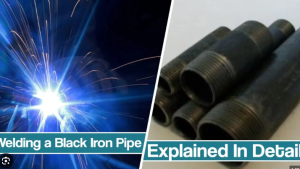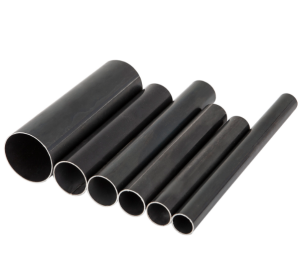Yes, black steel pipe can be welded using techniques like MIG, TIG, or Stick welding after proper surface cleaning and preparation.
Preparations for Welding Black Steel Pipe
Welding black steel pipe requires thorough preparation to ensure a strong weld and to maintain safety throughout the process. Proper cleaning of the pipe and adherence to safety measures are critical steps before starting the welding operation. Additionally, gathering all necessary equipment and materials ahead of time streamlines the workflow and minimizes risks.
Cleaning and Safety Measures
Cleaning Black Steel Pipe
Before welding, it’s essential to clean the black steel pipe to remove any oil, grease, or dirt as well as the oxide layer that may have formed on its surface. A comparison of cleaning methods shows that using a wire brush or grinder is effective for mechanical cleaning, achieving a clean surface that improves weld quality. For chemical cleaning, applying a degreaser can remove contaminants that are not visible to the eye.
Safety Measures
Welders must wear appropriate personal protective equipment (PPE), including a welding helmet with proper shading to protect the eyes from harmful arcs and sparks, leather gloves to prevent burns, and flame-resistant clothing to protect against hot metal and sparks. The workspace must be well-ventilated to avoid inhalation of harmful fumes. According to safety data, proper ventilation can reduce the risk of respiratory problems by up to 70%.
Equipment and Materials Needed
Welding Equipment
Choosing the right welding machine significantly affects the quality of the weld. For black steel pipes, a TIG welder or a MIG welder are the most commonly used. TIG welding provides higher precision and quality but at a slower speed and higher cost, with average equipment costs ranging from $1,200 to $3,500. MIG welding, on the other hand, offers a faster welding process and is easier to learn, making it suitable for both beginners and experienced welders, with prices ranging from $700 to $2,500.
Welding Materials
The materials required for welding black steel pipe include a suitable filler metal, typically a wire or rod composed of a compatible steel alloy. The choice of filler material affects the weld’s strength and durability.
A common filler metal for black steel pipe is ER70S-6, known for its superior tensile strength of up to 70,000 psi compared to other materials. Additionally, welders need shielding gas, such as argon for TIG welding or a mixture of argon and carbon dioxide for MIG welding, to protect the weld pool from contamination. The cost of shielding gas varies, but on average, a cylinder can cost between $50 and $150, depending on size and type.
By focusing on these detailed preparations, welders can ensure a safer environment and higher quality welds on black steel pipes, setting the groundwork for successful welding projects.

Welding Methods for Black Steel Pipe
Welding black steel pipe involves various methods, each with its unique advantages, limitations, and applications. Understanding the differences in efficiency, cost, and suitability for specific projects is essential for achieving optimal results.
MIG (Metal Inert Gas) Welding
MIG Welding Overview
MIG welding stands out for its efficiency and ease of use, making it a preferred method for both beginners and professionals. This process involves feeding a continuous wire electrode through a welding gun, along with a shielding gas to protect the weld pool from contamination.
Advantages
MIG welding allows for faster welding speeds compared to TIG and Stick welding, significantly reducing project time. For instance, in a test comparing welding methods on black steel pipe, MIG welding completed the weld in half the time it took to TIG weld the same joint. This method is also more adaptable to different thicknesses of black steel pipe, providing flexibility across various projects.
Cost and Materials
The initial setup cost for MIG welding can range from $700 to $2,500, depending on the equipment’s quality and capabilities. While MIG welding has a relatively higher operational cost due to the need for consumables like wire and shielding gas, its speed and efficiency can offset these costs in high-volume projects.
TIG (Tungsten Inert Gas) Welding
TIG Welding Overview
TIG welding offers unparalleled control and precision, making it ideal for high-quality welds in critical applications. This method uses a non-consumable tungsten electrode to produce the weld, with the filler metal added separately to the weld pool.
Advantages
The precision of TIG welding results in stronger, cleaner welds with minimal spatter and no slag, eliminating the need for post-weld cleanup. This makes it particularly suitable for applications requiring a high level of finish or where weld integrity is paramount.
Cost and Materials
TIG welding equipment is generally more expensive, with costs ranging from $1,200 to $3,500. The process is slower than MIG welding, which can increase labor costs. However, the superior quality of TIG welds can justify the higher price, especially for specialized applications.
Stick Welding (Shielded Metal Arc Welding)
Stick Welding Overview
Stick welding is one of the oldest welding methods, known for its simplicity and versatility. It uses a consumable electrode coated in flux to lay the weld and shield the weld pool from contaminants.
Advantages
Stick welding is highly effective for outdoor welding or in environments where it’s impractical to use gas shielding, due to its resistance to wind. The equipment is also relatively inexpensive, with basic setups available for under $500, making it accessible for hobbyists and small-scale projects.
Cost and Materials
Although the equipment cost is low, stick welding can be slower and less efficient than MIG or TIG welding, potentially leading to higher labor costs for large projects. The consumable electrodes also contribute to ongoing costs, though these are generally lower than the consumables for MIG welding.
Challenges in Welding Black Steel Pipe
Welding black steel pipe presents several challenges that can affect the outcome and quality of the welding project. Understanding how to effectively deal with coating and corrosion, as well as how to control heat and prevent distortion, are crucial for achieving optimal welding results.
Dealing with Coating and Corrosion
Impact of Coating and Corrosion
Black steel pipe often comes with a varnish coating to prevent rust during storage and transport. This coating must be thoroughly removed before welding, as it can contaminate the weld pool, leading to poor weld quality and potential weld defects. Similarly, any corrosion on the pipe surface can introduce impurities into the weld, weakening the joint.
Effective Removal Techniques
Mechanical removal methods, such as grinding or using a wire brush, are effective for eliminating both the coating and surface rust. Chemical cleaners can also be used to treat the pipe surface, but they require careful handling and proper disposal. Ensuring the pipe is clean and dry before welding can significantly reduce the risk of contamination and improve weld integrity.
Heat Control and Distortion Prevention
Challenges of Heat Management
Excessive heat input during welding can lead to distortion, changing the shape of the black steel pipe and potentially causing misalignment in assemblies. Proper heat control is essential to maintain the dimensional accuracy of the welded structure.
Strategies for Minimizing Distortion
To prevent distortion, welders can use techniques such as backstepping and stitch welding, which involve short welding passes with cooling intervals. Applying a controlled and consistent heat input throughout the welding process also minimizes the thermal stress on the pipe. Implementing proper jigging and fixturing can help maintain alignment and counteract the effects of heat-induced distortion.
By addressing these challenges head-on, welders can enhance the quality and durability of welds on black steel pipes. Removing coatings and corrosion properly ensures a clean welding surface free of contaminants, while adept heat management and distortion prevention techniques maintain the structural integrity and accuracy of the welded assembly. These measures are essential for the successful completion of projects involving black steel pipe, ensuring that the final welds meet or exceed the required standards and specifications.

Post-Welding Procedures
After completing the welding of black steel pipe, it’s crucial to follow specific post-welding procedures to ensure the integrity, strength, and longevity of the weld. These procedures include inspection and testing for quality assurance, along with applying finishing touches and protective measures.
Inspection and Testing for Quality Assurance
Ensuring Weld Quality
Upon completion of welding, conducting thorough inspections and tests is critical to verify the quality of the welds. Visual inspection is the first step, focusing on identifying any obvious defects such as cracks, porosity, or incomplete fusion.
Advanced Testing Techniques
For more detailed analysis, non-destructive testing (NDT) methods like ultrasonic testing, radiographic testing, and magnetic particle inspection are employed. Ultrasonic testing, for example, can detect subsurface flaws by measuring the reflection of high-frequency sound waves, while radiographic testing uses X-rays to reveal hidden defects within the welded joint.
Finishing Touches and Protective Measures
Achieving a Smooth Finish
After confirming the weld’s integrity, applying finishing touches can enhance the appearance and functionality of the welded area. Grinding and polishing the weld seam not only improves its aesthetic appeal but can also eliminate any sharp edges or protrusions that might cause injury or interfere with further assembly or installation processes.
Applying Protective Coatings
To protect the welded black steel pipe from corrosion and environmental damage, applying a protective coating is essential. Choosing the right type of coating—such as paint, powder coating, or a specialized anti-corrosion formula—depends on the pipe’s intended use and the specific environmental conditions it will face. For instance, in highly corrosive environments, epoxy coatings are favored for their durability and resistance to chemicals and moisture.
By diligently following these post-welding procedures, manufacturers and welders can ensure that their welded black steel pipes meet all required standards and specifications, offering reliability and longevity in their applications. These steps are vital in maintaining the quality and performance of the welded structures, ensuring they are fit for purpose and capable of withstanding the demands of their intended use.




